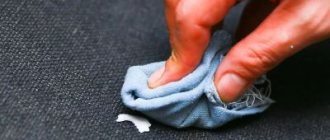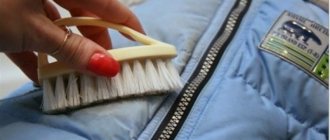Velcro on shoes needs to be cleaned. Yes - yes, don't be surprised. It does not fasten precisely because dirt has accumulated on it, which is not always visible to the eye. And if, upon closer examination, you see fluff, pellets and other contaminants, you should get down to business without delay.
Don’t throw away shoes that don’t fasten well; try putting in a little work and fixing the damaged Velcro with your own hands.
How to easily remove dirt from Velcro on shoes
Velcro is one of the most popular fasteners today, it is fast and convenient for both children and adults. This product consists of a large number of small hooks that catch small loops, because of this it can not only be easily fastened, but it also gets clogged quite quickly. Unfortunately, after this the fastener stops working properly. In this article, you will learn some simple ways to clean sticky shoe fasteners.
Important preliminary point
We will describe more than one life-saving method for restoring sticky fasteners. Choose the one that suits you. But before you get started, be sure to treat the adhesive fastener with an alcohol-based compound. This could be perfume or cologne, vodka, alcohol-based medical antiseptics, even alcohol-based medications are suitable if nothing else is available.
Alcohol treatment is necessary to remove greasy contaminants that may cause a defect. Sometimes alcohol solutions can help restore the functionality of the adhesive fastener without further cleaning.
Important! For alcohol treatment, do not use cotton swabs. Cotton fibers become clogged in the fastener, making it more difficult to clean. Use microfiber or sponge.
Using your fingers
It is easy to find out that the fastener is clogged. It will begin to unfasten frequently and this will cause inconvenience. Then it will be necessary to rid it of contaminants in order to restore functionality. First, try this with your fingers. Just start pulling out anything that sticks out from the mechanical part of the shoe in the same way as you clean a hairbrush.
This method should be used first as soon as a problem appears. The good thing about it is that no matter where you are, at home, at work or on vacation, you can always use it and not think about the issue of discomfort. This method will help you maintain the functionality of your fastener, as it is less traumatic for the structure. Therefore, monitor the amount of accumulated dirt as often as possible.
If you still have dirt, then complete the process by using the other side of the Velcro, connecting it to the dirty side several times. This method can be easily taught to a child, then he himself will be able to rid his shoes of an unpleasant problem.
“The Velcro keeps coming off!”
And the Velcro themselves are good, there is no need to change them. It is necessary to increase the area of these Velcro strips by sewing new ones directly on top. Why don't we remove these? But they don't interfere. Cut out the details.
We cut along the contour, threads and so on.
This is what happened. If you don't know where to look, you won't see it. They run away for two months, but nothing more is required of them.
Thanks for reading!
Let your Cats have a good rest and not overwork themselves.
And as usual: My posts are about shoe repair. Let's do it again. O. Repair. Shoes. Not about economics, politics, psychology, but about shoe repair. In addition to the pairs described in the post, I repair many others. But I think the more complex the source material, the more interesting the renovation story can be, right? Let’s stop asking the questions “why repair this”, “I would throw it away”, “new ones are easier” and so on. Each person decides for himself what to do. And I already repaired these shoes and gave them away. And I will not call a person to convey the opinion of a clavadrote unfamiliar to him. I hope none of my clients are stupid. In any case, these are adults, mature people who earn their own money and spend their money as they see fit. And, believe me, they are not interested in your advice. They most likely don’t even see them, although this is not a fact. Let's get more serious somehow, shall we? Abstract from the pair in question and simply look at the repair operations.
Source
Using sharp objects
They can be used to carefully remove dirt from the hooks. The following sharp objects should be used:
- tweezers;
- toothpick;
- hook;
- or a knitting needle.
Or any similar item. Here are a few steps you need to follow to clean the Velcro:
- Carefully use a toothpick or needle to pry up the debris between the hooks (they are located parallel) and remove it. You need to clean the rows in order.
- Then pull out the fluff and dust that was stirred up by the previous action with tweezers.
This method will take you longer as it requires care and careful actions. Its advantage is that you will achieve a better result, and, accordingly, repeated cleaning will not be required soon. Try to act carefully, as sharp products can damage not only the clasp, but also you.
Piercing method
Velcro itself is the same as hooks and loops, only very small. If you look closely, you will see that there are tiny loops on one side of the clasp, and the same microscopic hooks on the other.
Any sharp objects will help to clean both sides efficiently:
- Toothpick.
- Spoke.
- Needle.
- Crochet hook.
- Thin knife.
- Tweezers with sharp edges.
The algorithm of your actions is simple: with any sharp object of your choice, carefully clean each transverse row between the loops and hooks. Remove dirt with tweezers or your fingers.
Then repeat the procedure with longitudinal movements. Be careful not to tear the adhesive structure of the fastener. Cleaning with sharp objects will take more time than washing or cleaning with tape. But the result will be of high quality.
Using a toothbrush
Surely every housewife has an old toothbrush lying around somewhere in her toilet cabinet, which can be useful for solving such a problem. And if not, then this will be your incentive to buy a new one for yourself and use the old one for other purposes. An eyebrow brush or, if you have a cat or dog, a pet brush can also work. To clean the product using this method, you need to run the bristles along the Velcro in one direction, for example, from bottom to top, until all the dirt comes off and the fastener becomes clean again.
It is better to use a toothbrush after you have removed larger debris in a different way, and Velcro is not yet fully effective.
But if suddenly there is no old toothbrush in the cabinet, and a new one was purchased quite recently, do not despair. Instead of a hygiene item, you can use a small plastic comb with fine teeth, which will also perfectly clean the lock of accumulated dirt.
Mechanical cleaning
The most common problem with Velcro is that pieces of thread, fluff, and hair get between the hooks. The largest fragments can be cleaned out by hand. Simply unfasten the Velcro, grab foreign objects with your nails and pull them out. The clasp will regain its previous functionality.
If your nails are not long enough and the debris is too small, then it is better to use simple tools to remove the dirt from the hard part of the Velcro. This could be tweezers, a toothpick, a hook, a knitting needle, a comb, a knife, nail scissors, a screwdriver, an awl, a hairpin, a pin, etc. Pass a sharp object between the rows of Velcro hooks, moving along, and when the debris comes out, pull it out with tweezers. Do everything carefully, as sharp objects can damage both the Velcro and your hands.
For mechanical cleaning, you can also use an old toothbrush with soft bristles, an eyebrow comb, a fine-tooth comb, or a slicker brush that is used to clean pet hair. They have a dense arrangement of bristles and teeth. Therefore, they can quickly, literally in a few movements, clean the Velcro without damaging it. Peel off the soft part of the fastener, and then comb the hard side to remove dirt from it.
How to clean Velcro on shoes
Thanks to the alkali contained in the composition, you can very quickly remove all the fluff and dust accumulated between the hooks. To do this you need to make just a few movements:
- Use warm water and soap to make a small amount of soapy water.
- Next, using parallel movements along the hooks, comb the Velcro with a toothbrush.
This method is ideal for removing fat particles as well. But, if your loop side (the softer side) is dirty, then wash it with your fingers without using a brush.
This method can be combined with the main wash, but if the stain is only on the Velcro, then you should not wash everything together, as it will take you longer to dry completely. Dip only the problem area of your item into the soap solution.
If time is sorely lacking
If you don’t like wasting time on manual manipulations, but need to update the Velcro urgently, you can wash your shoes. It doesn’t matter how you do it – in a car or with your hands. The alkaline component of soap or powder is great for removing dirt on shoes, including velcro.
Important! When washing shoes, remember that Velcro, zippers, and buttons must be fastened.
And this method has a significant drawback, again temporary. When washing in a machine, your own hands will be free, but shoes cannot be put on until completely dry. But if we talk about the functionality of the shoes, if the Velcro doesn’t stick, you still won’t be able to wear the shoes.
Using adhesive tape
It is also an effective way to achieve results and high-quality functioning of the fastener. Most likely, each of the readers will have this stationery item at home. Here's what to do:
- Loosen any stuck debris using any of the previous methods.
- Run duct tape over the surface. This step can be repeated several times to completely clean the hooks.
This method will not make you wait long for results. The approximate time it will take you is a maximum of 5 – 10 minutes. This method can be easily used not only at home, but at work or at school, when a problem finds you in an unexpected place and at an unexpected time.
Non-standard methods
Fluff, dust, particles of grease and dirt between the Velcro hooks can be cleaned with water and soap. Prepare a soap solution and use an old toothbrush to comb through the Velcro. If you need to work on the soft side of the Velcro, do it with your hands without a brush.
Sometimes ordinary adhesive tape helps to clean out debris between the Velcro hooks. To do this, you need to stir up the stuck fluff by lifting it with a brush, needle or knitting needle, apply the adhesive side of the tape to the hard surface of the Velcro and tear it off with a sharp movement.
Using a special Lintscoop tool
Nowadays, people are trying to make their lives easier by coming up with all sorts of special accessories, such as the Lintscoop. This unusual device is a plastic toothed brush that can be used to easily and quickly remove excess debris from the connecting part of shoes and any other item without damaging its hooks and eyelets. All you have to do is brush the Linscoop over the desired area a few times and your item is clean and functional. You are unlikely to find such a device in a convenience store or specialized supermarkets for household chemicals. However, if you want to quickly and easily fix broken Velcro, you can easily order such a brush in specialized catalogs.
Why doesn't the clasp work?
Miniature hooks are located on the hard surface of the fastener, which ensure adhesion. The other side of the product is softer and fleecy.
Velcro can stop working for several reasons. Firstly, the space between the hooks sometimes becomes clogged with household waste. This can be hair, threads from various fabrics, dust and sand. In this case, it is enough to remove the dirt from the plastic.
The second reason is more complicated: the clasp wears out from prolonged use, the hooks break off and do not cling to the soft part. All that remains is to replace the device in the workshop.
The third reason: the fleecy side is too fluffy and cannot withstand the load when moving. Then it is necessary to carry out a simple procedure to restore the functioning of the working surface.
With the help of other small household items
In fact, there are many more options for cleaning a sticky fastener. Here are some of them:
- roller for cleaning clothes (just roll it over the dirty area);
- A shoe brush will also help solve the problem.
But you can use a very simple option - dry cleaning. Using special tools, specialists will remove any Velcro on your shoes for a nominal fee. Although all of the above methods will help you solve the problem just as well as professionals.
If you want to maintain the quality of Velcro for a long time, then you should keep it fastened as often as possible, including when you wash the item in the washing machine. During washing, threads and spools that come off the items can easily clog the hooks of the fastener and not only fail to clean it, but also ruin it!
With these simple methods you can easily achieve the desired result and quickly bring a dirty fastener into a presentable appearance. The main thing to remember is that if you want to clean it using one of the indicated methods, try to be careful, since a dirty product can be cleaned, but with a broken one, things are more complicated.
The most accessible method
You can restore Velcro on shoes very simply - clean them with your fingers. Choose a comfortable bright place, get comfortable, and carefully, millimeter by millimeter, begin to remove dirt from the Velcro. Large pellets and other contaminants can be easily removed by hand; all you need is patience. Once the visible dirt has been removed, try fastening your shoes. It happens that simple hand cleaning saves shoes from being thrown away.
Please note that the only drawback of this method is the time it takes.
But you won’t have to spend your budget on special chemicals, brushes or paying for the services of dry cleaning specialists.
When is replacement needed?
Not every Velcro can be revived; sometimes, in order to restore functionality, it is necessary to replace it partially or entirely. This will have to be done if the soft part of the Velcro is completely frayed and does not adhere to the hard surface. In addition, if the hooks on the hard side of the Velcro are bent, they will also not be able to perform their functions. In this case, you need to tear off the damaged part of the Velcro and sew a new fastener in its place. You can do this yourself, or at a clothing or shoe repair shop.
Nowadays, many clothes have Velcro instead of a normal fastener. This is, of course, convenient, but often after washing the Velcro stops holding on. I have the same problem now with the sleeves of my autumn jacket; they are held on by Velcro, which has ceased to function properly. Is it possible to restore the stickiness of the fastener?
Author of the publication
Natalka
Achievement received 02/02/2019
Title: Reliable Bearded Man
Achievement received 09.28.2018











